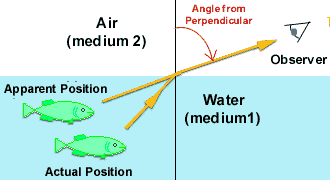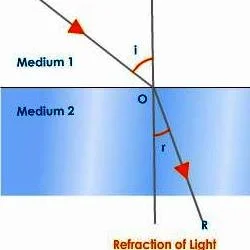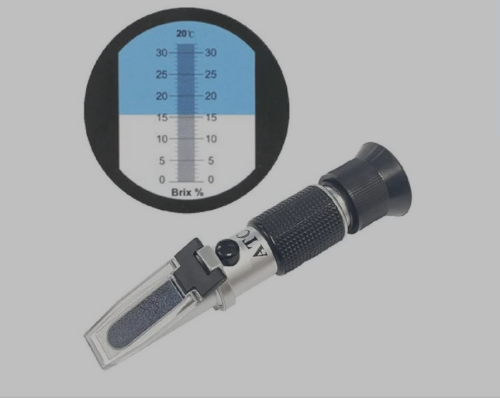
Brix is a scale based on the amount that light bends when it passes through a liquid. If one were to place one's hand in a pond and measure the amount it appeared to bend, and then place it in the ocean, it would appear to bend a different amount. That differential light bending is the best tool currently available to consumers to determine the value of crops that are purchased or produced. The brix chart is the scale anyone can use to determine poor, average, good or excellent in a foodstuff. The Brix chart was developed by Carey Reams. Dr. Carey A. Reams was a a Florida native and agricultural engineer who ran a large lab in Orlando from 1931 to 1968, and made Brix a popular method in food production. In his college years, Reams discovered huge differences in the mineral content of fruits and vegetables, depending on how and where they were grown. He retired to further his research and give seminars and lectures all around the country.
One of the benefits of joining Bionutrient Food Association as a member is the option to purchase a "brix kit" at a significantly discounted cost available to members only. The brix kit comes with a brix chart, refractometer and brix press that can be used on all fruits and vegetables to enable rapid quality testing.
HOW DOES BRIX RELATE TO QUALITY?
Centuries of wine making and work with other fruits and vegetables always show direct relations between high Brix and high quality, expressed most simply and directly as superior taste. Brix varies directly with plant quality. For instance, a poor, sour tasting grape from worn-out land can test 8 or less brix. On the other hand, a full flavored, delicious grape, grown on rich, fertile soil can test 24 or better brix. The process is somewhat altered for the gardener or farmer in that they test the leaf of the growing plant much earlier and are therefore afforded the opportunity to correct soil deficiencies before the crop matures. The gardener or farmer also benefits in that they soon learn that any crop with 12 or better leaf Brix will not be bothered by insect pests.
Brix measures the percent solids (TSS) in a given weight of plant juice‚ nothing more‚ nothing less.
**Remember that sugar is only one of the components of brix. Also remember that many other substances can falsely indicate "brix" readings: rubbing alcohol, whiskey, vinegar, or wine (although those readings are valid in their own right). Interestingly, cooking oil, molasses, syrup, and other thick liquids require a refractometer calibrated to read 30-90 brix. Honey is checked with a refractometer calibrated to measure the water in it instead of solids in water.
SO WHAT EXACTLY IS BRIX?
"Brix" is a technical term to measure and quantify the amount that light is bent passing through a fluid.
We have all seen the optical effect of a pencil sticking out of water. The straight pencil appears to be bent where it enters the water. This is because water has a different density than air, and so light travels at a different speed in water than in air. Thus, the pencil seems bent.
Actually, it is the light which is bent, not the pencil.
Fishermen must account for this optical displacement effect when they look into water for fish. A fish will appear to be in one location, but its true location may be a few inches away because light bends as it passes from water to air.
This difference between apparent and actual location is caused by this light-bending effect of the different densities of air and water.
Other liquids, glass, transparent crystals, many biological molecules, and other more exotic materials also bend a beam of light. This "refraction" is what gives diamonds and other gems their brilliance and sparkle.
WHAT IS REFRACTION?
"Refraction" is the technical term scientists use to denote this light-bending effect of water and other materials. Each substance will bend - or "refract" - light at a different angle, depending on its specific density. This angle of refraction also changes with certain other conditions, including especially temperature, frequency, magnetism, and concentration.
Scientists have carefully studied many materials to measure how much each will bend a light beam, and created ways to quantify this effect for each material. This numerical data is an index of refraction for that specific substance at a specific temperature.
Some substances, such as quartz crystal, bend different frequencies of light at different angles. Low frequency red light bends less than higher frequency blue. This separates a beam of light into a band of frequencies, which appears to our eye as a rainbow spectrum of colors, from red to violet.
This property is used by chemists in a spectrometer to detect and measure the elemental composition of complex molecules and mixtures. Astronomers measure refraction of a star's light as its signature spectrum to determine its elemental composition, and also distance from Earth and speed.
HOW DOES DENSITY AFFECT REFRACTION?
Back down on Earth, in agriculture, measuring this light-bending effect provides useful information about the density of fluids, such as soil moisture, irrigation water, plant sap, fruit juice, blood, milk, cell protoplasm, or other body fluids. Pure water at a specific temperature will bend light at a specific angle. However, any chemical dissolved in the water will change the density of that liquid, and thus change its angle of refraction.
We have all watched salt or sugar crystals slowly sink down in a glass of water, and seen the curling bands of light and shadow that swirl and whorl around the grains as they sink and dissolve. Those bands of light and dark are due to varying light-bending effects of different densities in layers of water around each disassembling, dissolving, descending crystal.
A wide variety of biological substances can increase solution density, and thus cause light to refract (bend) more as it passes through a watery medium:
1. dissolved minerals (salts, acids, alkali)
2. carbohydrates (simple sugars)
3. amino acids (proteins)
4. lipids (special case: oil & water don't mix; form thin films)
5. almost any molecule with covalent bonding
6. very large suspended particles (colloids)
Measuring this change in the angle of refraction can give helpful data and insight about the density and chemical composition of that solution.
How does this affect plant sap? In the case of plant sap, it is primarily sugars in plant juice that cause refraction. This is because the primary activity of plants is photosynthesis‚ – using sunshine to combine carbon dioxide and water to form sugars. This sunlight stored in carbon rings is the primary source of energy for most of biology on Earth, including humans - especially our nervous system.
Thus, the principal substance carried by plant sap fluids is these energy-rich carbohydrate chemicals: sugars – the sweetness of life.
Normally, the second most abundant refractive substances in plant sap are mineral ions. However, sugars are quite large compared to mineral ions. Each sugar molecule consists of at least two dozen covalent bonds in a molecule composed of twenty to two dozen or more atoms. Thus, sugars tend to affect the index of refraction more than minerals.
Thus, Brix is mostly a measure of sugars and minerals dissolved in water. however, many other chemicals may be present and contribute some small factor to the Brix reading.
WHAT IS A REFRACTOMETER?
A refractometer is the instrument used to obtain a brix reading. This simple, hand-held measures the amount of refraction (or bend) in a beam of light that passes through the plant sap. A conscientious nutrient-dense grower takes regular, routine field measurements of plant sap density.
Refractometers come in three basic types:
Optical, Digital & Laboratory.
For growers, the first two are portable, handheld and simple to operate in the field. Digital refractometers are simpler to operate and easier to read. Just put a few drops of liquid in the well hole and press the switch. The Brix number appears in the digital readout. Both types work great, although the digital models require a battery to operate, and are much more expensive.
HOW TO USE AN OPTICAL REFRACTOMETER
Squeeze sap out of a plant.
Put 2 drops on the prism.
Close the prism cover.
Point to a light source.
Focus the eyepiece.
Read the measurement.
Where light & dark fields intersect is the brix number.
Optical refractometers require a few drops of solution to be spread thinly on the surface of a prism. Then, like a tiny telescope or microscope, you peer down a long hollow tube at the prism. Part of the light beam passes through the thin film of plant sap on the prism, while the rest bypasses this specimen.
An adjustment knob allows you to align light and dark areas on a screen to determine the angle of refraction, and thus the solution density. A scale in the viewfinder allows you to easily identify the Brix number.
WHAT PLANT PART IS USED FOR BRIX READING?
Whatever part you eat, if it is ripe. If it is not ripe, take the most recent mature leaves that have had at least two hours of full sunlight. Ideally, measurements are taken at the same time of day every day, so you can compare throughout the growing season.
WHY IS IT CALLED BRIX?
Professor Adolf Ferdinand Wenceslaus Brix, a 19th Century German chemist (1798-1890), was the first to measure the density of plant juices. Europe's winemakers could not predict which of various grape juices would make the best wine. Being able to judge quality ahead of actual bottling was of immense importance in an industry where a bottle of the best wine might sell for hundreds of times more than a bottle of everyday wine.
Professor Brix's hydrometer worked, but it was cumbersome and required a tall graduate of juice to actually conduct the measure. This was OK for the vineyard wine cellar, but a nuisance to the grower in the field who wished to squeeze perhaps a single growing grape to judge its potential quality.
Professor Brix was greeted as a great hero when he emerged from his laboratory to claim his most generous prize. He was also honored by having the measuring process named after him.
Adolf Ferdinand Wenceslaus Brix (b. February 20, 1798 in Wesel, d. February 14, 1870 in Charlottenburg, Berlin) was a German mathematician and engineer. The unit degree Brix (°Bx) for specific gravity of liquids is named after him.
Brix made a career as a civil servant in professions related to civil engineering, measurements and manufacture (1827 Bauconducteur, 1834 Fabriken-Commisionsrath, 1853 geheimer Regierungsrath) and retired in 1866 (when he was promoted to geheimer Oberregierungsrath). He was director of the Royal Prussian Commission for Measurements, member of a technical committee in the Ministry of Trade, and the technical building committee. He was also a teacher of applied mathematics at Gewerbeinstitut zu Berlin (1828-1850), as well as in higher analysis and applied mathematics at the Bauakademie, both of which are forerunners of the Technical University of Berlin.
WHO WAS CAREY REAMS
Dr. Carey A. Reams was a a Florida native and agricultural engineer who ran a large lab in Orlando from 1931 to 1968, and made Brix a popular method in food production. In his college years, Reams discovered huge differences in the mineral content of fruits and vegetables, depending on how and where they were grown. He retired to further his research and give seminars and lectures all around the country.
Reams developed a following of farmers because they found that his methods produced crops of far superior quality. For many years, citrus and grape growers had used the Brix measurement to evaluate the quality of their produce. Reams took that knowledge and formulated a Brix chart, which covers most of the common fruits, vegetables and forage crops.
Shortly after Acres USA began publishing its monthly magazine on ecological agriculture, Reams noticed the paper's contributors talked about higher quality food production, no one had a method to measure and monitor such quality. One day Reams walked into Charles Walters' office with a copy of his Brix chart. The reverberations have been felt from one end of agriculture to the other.
Reams verified that the "soft" rock phosphate, washed away as an "impurity" while cleaning "hard" phosphate rock during the manufacture of acidulated phosphoric fertilizers was, indeed, a prime resource for the biological farmer. Combined with poultry litter and high-calcium lime, and all under the watchful eye of Reams, the formerly disdained soft rock phosphate produced superb highly-mineralized citrus as well as other crops.
Reams was well aware that citrus crop quality was directly proportional to juice richness. His years of incessant laboratory experiments had proven, over and over, that the mineral content of a crop marched in lockstep to the "heaviness" of the juice it contained.
History does not record when Reams first realized that the concept applied to other crops than grapes and oranges. Nor does history record when he first picked up a refractometer and said, "I wonder?" Did someone else say, "Dr. Reams, take a look at this," or did it come to him as inspiration?
Whatever the answer to those questions, it is known that he created a bombshell in the early 1970's when he, refractometer in hand, walked into the office of ACRES USA and placed a simple chart on the editor's desk. That chart correlated brix numbers with four general quality levels for most fruits and vegetables. Copied innumerous times, it has made its way around the world over and over.









